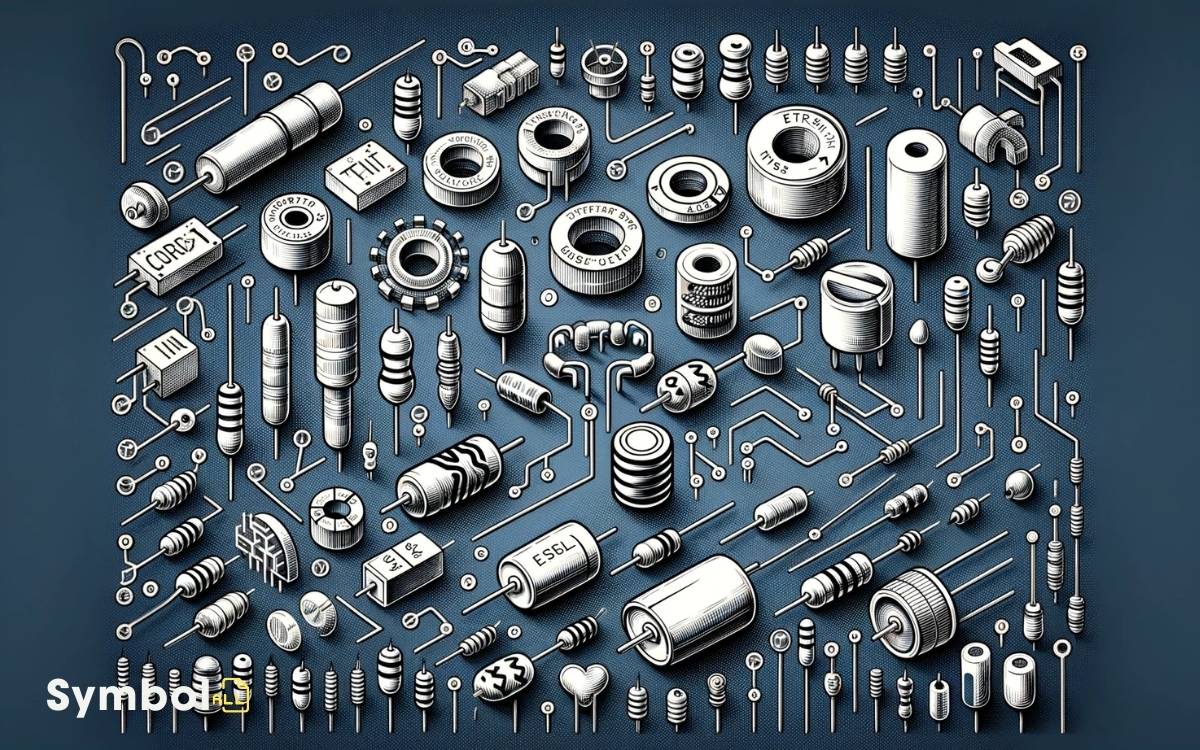Electric Symbols and Their Uses: Resistors, Capacitors!
In electrical diagrams, you’ll encounter basic symbols indicating components and connections. A simple line shows a wire, while intersecting lines represent a bus.
Circles denote connectors and terminals. Understanding these symbols is vital for precise circuit analysis.
Resistors, measured in ohms (Ω), regulate current flow and prevent damage, controlling circuit behavior accurately.
Capacitors, capable of storing electrical energy, are measured in farads (F) and stabilize voltage. Switches control electricity flow, with indicators providing status feedback.
Advanced components like microcontrollers, sensors, and integrated circuits have specific symbols, essential for interpreting complex circuits. Mastering these symbols enhances your ability to analyze and design circuits.

Key Takeaways
11 Electrical Symbols and Their Applications
| Symbol | Name | Description | Common Uses |
|---|---|---|---|
| ⏚ | Earth Ground | Represents the connection to the earth in an electrical system | Safety grounding in electrical circuits |
| ⭘ | Resistor | An electrical component that limits or regulates the flow of electrical current in an electronic circuit | Circuit boards, electronic devices |
| → | → | Capacitor | A device that stores electrical energy in an electric field |
| ⌁ | Inductor | A passive electrical component that stores energy in a magnetic field | Filters, energy storage, sensors |
| ⟿ | Diode | Allows current to flow in only one direction | Power conversion, signal demodulation |
| ⏛ | Transistor | Semiconductor device used to amplify or switch electronic signals | Amplification, switching, signal modulation |
| ⭘⃒ | Variable Resistor / Potentiometer | Resistor whose resistance can be adjusted manually | Volume control, tuning circuits |
| ≋ | Transformer | A device that transfers electrical energy between two or more circuits through electromagnetic induction | Power supplies, audio systems |
| ⏜ | Fuse | A safety device that protects an electrical circuit from excessive current | Protection of electrical circuits |
| ⏻ | Switch | An electrical component that can break an electrical circuit, interrupting the current or diverting it from one conductor to another | Lighting systems, power tools |
| ⭘⃨ | Light-Emitting Diode (LED) | A semiconductor light source that emits light when current flows through it | Indicators, displays, lighting. |
Understanding Basic Symbols
To effectively comprehend electrical diagrams, familiarizing yourself with the basic symbols that form the language of circuit design is essential.
These symbols represent the components and connections within a circuit, each with its unique function and purpose. Each component is depicted using a standardized symbol to ensure clear communication and understanding among engineers and designers. The symbol for voltage in calculations, for example, typically represents a voltage source or a potential difference, serving as a crucial element in analyzing circuit behavior. By combining these symbols in schematic diagrams, the overall functionality and flow of the circuit can be effectively planned and interpreted.
For instance, the simple line depicts a wire, the basic pathway for current flow. A series of lines intersecting at right angles symbolizes a bus, indicating multiple wires bundled together for organized signal management.
The circle, often with specific designations inside, denotes various connectors and terminals, serving as junction points for wire connections.
Understanding these symbols allows you to interpret the flow and functionality of electrical systems accurately.
Mastery of this symbolic language is the foundation upon which more complex circuit analysis is built, ensuring you can navigate and analyze electrical diagrams with confidence.
Resistors and Their Functions
Delving into the world of resistors, you’ll find they’re essential components that regulate the flow of current in an electrical circuit.
These devices are pivotal in ensuring that other components receive the correct current levels, thereby preventing potential damage.
Resistors achieve this through their inherent resistance, measured in ohms (Ω), which opposes the flow of electrical current. The higher a resistor’s ohm value, the more it impedes the current, allowing for precise control over the circuit‘s behavior.
Understanding the resistor’s role is vital for designing or troubleshooting circuits. By incorporating resistors with appropriate values, you can tailor the current flow, manage voltage divides, and even filter signals.
This capacity to modulate electrical current underscores the resistor’s significance in circuit design and analysis, making it a fundamental concept for anyone keen on understanding electrical systems.
Capacitors Explained
Moving from resistors, let’s explore capacitors, another fundamental component in electrical circuits that store and release electrical energy.
Unlike resistors which impede current flow, capacitors accumulate charge when connected to a power source, storing energy in an electric field.
This capability allows them to release energy when the circuit requires, making them pivotal in stabilizing voltage and power flow.
Capacitors consist of two conductive plates separated by an insulating material or dielectric. When voltage is applied, an electric field develops across the dielectric, allowing the capacitor to store energy.
The capacity to hold charge is measured in farads (F), though most practical capacitors have values ranging from picofarads (pF) to microfarads (μF).
Understanding their function and symbols in circuit diagrams is essential for managing energy storage and release in your projects.
Switches and Indicators
Switching our focus to switches and indicators, you’ll find these components are essential for controlling the flow of electricity and providing visual or auditory feedback within circuits.
Switches, whether manual or automatic, serve as gatekeepers, allowing or interrupting the current flow based on specific criteria or user input.
They’re depicted with symbols that vary depending on their type and function toggle, push-button, and relay switches are just a few examples.
Indicators, on the other hand, signal circuit status through light or sound. LEDs and lamps are common visual indicators, while buzzers serve as auditory alerts.
Understanding these symbols is vital for interpreting circuit diagrams accurately, ensuring you can follow the path of current and recognize when a circuit is active or in standby mode.
Advanced Components Overview
Exploring advanced components, you’ll encounter devices critical for enhancing circuit functionality and efficiency, such as microcontrollers and sensors.
Microcontrollers act as the brain within electronic systems, capable of executing programmed instructions to control other components. They’re essential in automation, where precise control over processes is required.
Sensors, on the other hand, serve as the eyes and ears, detecting changes in their environment temperature, pressure, or light and converting these into electrical signals. Understanding their symbols is vital for interpreting and designing complex circuits.
As you investigate further, you’ll also meet transducers, which convert one form of energy into another, and integrated circuits that perform specific functions, from amplification to data processing.
Mastering these symbols equips you with the ability to read and design sophisticated electronic systems.
Conclusion
You’ve now navigated the basics of electric symbols, from resistors, which manage the flow of current, to capacitors that store electric charge.
Switches and indicators, alongside pivotal components, play vital roles in complex circuits. Surprisingly, over 90% of electronic devices rely on these fundamental components.
Their precise functions and interactions underpin the functionality of modern technology. Understanding these symbols isn’t just academic; it’s a step towards mastering the language of electronics, essential for any aspiring technician or engineer.






